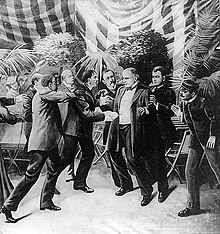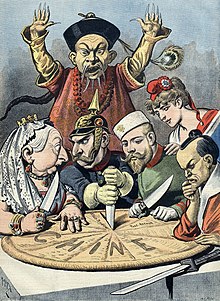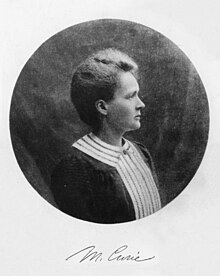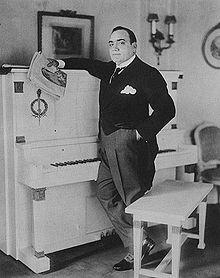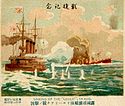Lata 1900. (dekada)
Wydarzenia
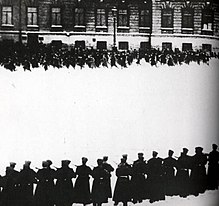
Krwawa niedziela w Petersburgu
- Śmierć królowej Wielkiej Brytanii i Irlandii Wiktorii Hanowerskiej, tron objął jej syn Edward VII.
- Zamach na Prezydenta Stanów Zjednoczonych Williama McKinleya.
- Rewolucja 1905 roku w państwie rosyjskim.
- Wojna rosyjsko-japońska.
- Zakończenie wojen burskich.
- Strajk szkolny w Królestwie Polskim.
- Nowy imperializm.
- Maria Skłodowska-Curie wraz z mężem Pierre Curie wspólnie otrzymują Nagrodę Nobla w dziedzinie fizyki.
- Albert Einstein opublikował szczególną teorię względności.
- Bracia Wright dokonali pierwszego lotu maszyną powietrzną wyposażoną w napęd.
- Max Planck przedstawił teorię kwantową.
- Karl Landsteiner odkrył istnienie grup krwi.
- Robert Edwin Peary dotarł saniami do bieguna północnego.
- Louis Bleriot dokonał pierwszego przelotu samolotem nad kanałem La Manche.
- Pierwszy wyścig kolarski Tour de France.
- Masowa produkcja samochodów.
- Pablo Picasso zapoczątkowuje kubizm.
Osoby
- Maria Skłodowska-Curie
- Pierre Curie
- Józef Piłsudski
- Wincenty Witos
- Roman Dmowski
- Henryk Sienkiewicz
- Julian Fałat
- Jacek Malczewski
- Stefan Żeromski
- Władysław Reymont
- Albert Einstein
- Bracia Wright
- Max Planck
- Robert Edwin Peary
- Louis Blériot
- Karl Landsteiner
- Pablo Picasso
- Eugen d’Albert
- Hugo Alfvén
- Egbert Van Alstyne
- Broncho Billy Anderson
- Fatty Arbuckle
- Kurt Atterberg
- Béla Bartók
- Nora Bayes
- Irving Berlin
- Francis Boggs
- Frank Bridge
- Alfred Bryan
- Vincent P. Bryan
- Ferruccio Busoni
- Enrico Caruso
- Gustave Charpentier
- Thurland Chattaway
- Francesco Cilea
- Will D. Cobb
- George M. Cohan
- Bob Cole
- Frederick Converse
- Henry Creamer
- Walford Davies
- Peter Dawson
- Claude Debussy
- Frederick Delius
- Paul Dresser
- Antonín Dvořák
- Gus Edwards
- Edward Elgar
- August Enna
- Manuel de Falla
- Geraldine Farrar
- Fred Fisher
- Paul Le Flem
- Rudolf Friml
- Julius Fučík
- Amelita Galli-Curci
- Mary Garden
- Edward German
- Aleksandr Głazunow
- Emilio de Gogorza
- Percy Grainger
- Enrique Granados
- David Wark Griffith
- Guy d’Hardelot
- Hamilton Harty
- The Haydn Quartet
- Anna Held
- Victor Herbert
- Max Hoffmann
- Gustav Holst
- Abe Holzmann
- David Horsley
- Mississippi John Hurt
- Jenő Huszka
- Michaił Ippolitow-Iwanow
- Carrie Jacobs-Bond
- William Jerome
- J. Rosamond Johnson
- James Weldon Johnson
- Scott Joplin
- Gus Kahn
- Jerome Kern
- Rudyard Kipling
- Carl Laemmle
- Harry Lauder
- Leadbelly
- Franz Lehár
- Ruggero Leoncavallo
- Paul Lincke
- Gustav Mahler
- Arthur Marshall
- Jules Massenet
- Nikołaj Medtner
- Nellie Melba
- Georges Méliès
- Kerry Mills
- Billy Murray
- Ethelbert Woodbridge Nevin
- Carl Nielsen
- Jack Norworth
- Vítězslav Novák
- Maude Nugent
- Sidney Olcott
- Charles Pathé
- Edwin S. Porter
- Giacomo Puccini
- Siergiej Rachmaninow
- Maurice Ravel
- Ottorino Respighi
- Nikołaj Rimski-Korsakow
- Landon Ronald
- Paul Sarebresole
- Arnold Schönberg
- Jean Schwartz
- James Scott
- Aleksandr Skriabin
- William Selig
- Chris Smith
- Harry B. Smith
- Ethel Smyth
- John Philip Sousa
- George K. Spoor
- Charles Villiers Stanford
- Andrew B. Sterling
- Oscar Straus
- Richard Strauss
- Igor Strawinski
- Leslie Stuart
- Josef Suk
- Siergiej Taniejew
- Albert Von Tilzer
- Harry Von Tilzer
- Tom Turpin
- Edgar Varèse
- Vesta Victoria
- Anton Webern
- Percy Wenrich
- Bert Williams
- Harry Williams
- Ermanno Wolf-Ferrari
- Amy Woodforde-Finden
- Israel Zangwill
- Charles A. Zimmerman
Przypisy
- ↑ Lekarski Poradnik Językowy, www.lpj.pl [dostęp 2020-07-09] (pol.).
- ↑ YouTube, www.youtube.com [dostęp 2020-07-09] (ang.).
Media użyte na tej stronie
Albert Einstein photo 1920.jpg
Photograph of Albert Einstein in his office at the University of Berlin, published in the USA in 1920.
Photograph of Albert Einstein in his office at the University of Berlin, published in the USA in 1920.
Enrico Caruso.jpeg
Enrico Caruso in front of his white Empire style upright piano, a present of the piano manufacturer Hardman, Peck and Company, in his apartment in New York City. Reference: Fryer, Paul (2005). The Opera Singer and the Silent Film. Jefferson, NC: McFarland. p. 38 f.
Enrico Caruso in front of his white Empire style upright piano, a present of the piano manufacturer Hardman, Peck and Company, in his apartment in New York City. Reference: Fryer, Paul (2005). The Opera Singer and the Silent Film. Jefferson, NC: McFarland. p. 38 f.
China imperialism cartoon.jpg
"China -- the cake of kings and... of emperors" (a French pun on king cake and kings and emperors wishing to "consume" China). French political cartoon from 1898. A pastry represents "Chine" (French for China) and is being divided between caricatures of Queen Victoria of the United Kingdom, William II of Germany (who is squabbling with Queen Victoria over a borderland piece, whilst thrusting a knife into the pie to signify aggressive German intentions), Nicholas II of Russia, who is eyeing a particular piece, the French Marianne (who is diplomatically shown as not participating in the carving, and is depicted as close to Nicholas II, as a reminder of the Franco-Russian Alliance), and a samurai representing Japan, carefully contemplating which pieces to take. A stereotypical Qing official throws up his hands to try and stop them, but is powerless. It is meant to be a figurative representation of the Imperialist tendencies of these nations towards China during the decade.
"China -- the cake of kings and... of emperors" (a French pun on king cake and kings and emperors wishing to "consume" China). French political cartoon from 1898. A pastry represents "Chine" (French for China) and is being divided between caricatures of Queen Victoria of the United Kingdom, William II of Germany (who is squabbling with Queen Victoria over a borderland piece, whilst thrusting a knife into the pie to signify aggressive German intentions), Nicholas II of Russia, who is eyeing a particular piece, the French Marianne (who is diplomatically shown as not participating in the carving, and is depicted as close to Nicholas II, as a reminder of the Franco-Russian Alliance), and a samurai representing Japan, carefully contemplating which pieces to take. A stereotypical Qing official throws up his hands to try and stop them, but is powerless. It is meant to be a figurative representation of the Imperialist tendencies of these nations towards China during the decade.
Battle off Ulsan.jpg
Sinking of the "Leulic", 14 Aug. Sinking of the Russian cruiser Rurik in the Battle off Ulsan during the Russo-Japanese War, 1904, from a contemporary propaganda postcard
Sinking of the "Leulic", 14 Aug. Sinking of the Russian cruiser Rurik in the Battle off Ulsan during the Russo-Japanese War, 1904, from a contemporary propaganda postcard
McKinleyAssassination.jpg
assassination of President William McKinley by Leon Czolgosz at Pan-American Exposition reception on September 6, 1901.
assassination of President William McKinley by Leon Czolgosz at Pan-American Exposition reception on September 6, 1901.
Wrightflyer.jpg
First successful flight of the Wright Flyer, by the Wright brothers. The machine traveled 120 ft (36.6 m) in 12 seconds at 10:35 a.m. on 17 December 1903 at Kitty Hawk, North Carolina. Orville Wright was at the controls of the machine, lying prone on the lower wing with his hips in the cradle which operated the wing-warping mechanism. Wilbur Wright ran alongside to balance the machine, and just released his hold on the forward upright of the right wing in the photo. The starting rail, the wing-rest, a coil box, and other items needed for flight preparation are visible behind the machine. This was considered "the first sustained and controlled heavier-than-air, powered flight" by the Fédération Aéronautique Internationale.
First successful flight of the Wright Flyer, by the Wright brothers. The machine traveled 120 ft (36.6 m) in 12 seconds at 10:35 a.m. on 17 December 1903 at Kitty Hawk, North Carolina. Orville Wright was at the controls of the machine, lying prone on the lower wing with his hips in the cradle which operated the wing-warping mechanism. Wilbur Wright ran alongside to balance the machine, and just released his hold on the forward upright of the right wing in the photo. The starting rail, the wing-rest, a coil box, and other items needed for flight preparation are visible behind the machine. This was considered "the first sustained and controlled heavier-than-air, powered flight" by the Fédération Aéronautique Internationale.
